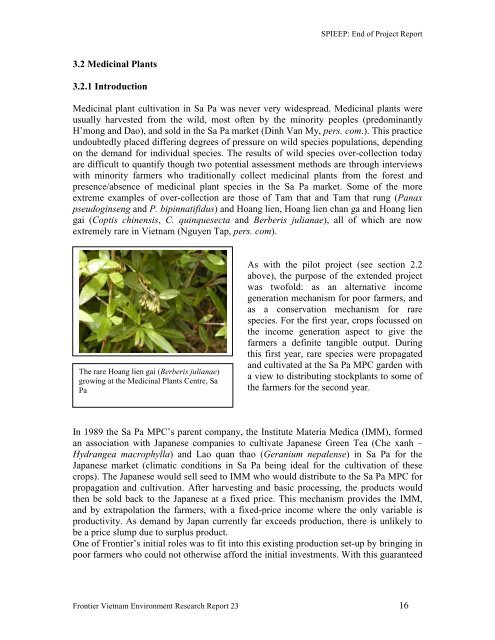Frontier Tanzania Environmental Research - Frontier-publications ...
Frontier Tanzania Environmental Research - Frontier-publications ...
Frontier Tanzania Environmental Research - Frontier-publications ...
Create successful ePaper yourself
Turn your PDF publications into a flip-book with our unique Google optimized e-Paper software.
SPIEEP: End of Project Report3.2 Medicinal Plants3.2.1 IntroductionMedicinal plant cultivation in Sa Pa was never very widespread. Medicinal plants wereusually harvested from the wild, most often by the minority peoples (predominantlyH’mong and Dao), and sold in the Sa Pa market (Dinh Van My, pers. com.). This practiceundoubtedly placed differing degrees of pressure on wild species populations, dependingon the demand for individual species. The results of wild species over-collection todayare difficult to quantify though two potential assessment methods are through interviewswith minority farmers who traditionally collect medicinal plants from the forest andpresence/absence of medicinal plant species in the Sa Pa market. Some of the moreextreme examples of over-collection are those of Tam that and Tam that rung (Panaxpseudoginseng and P. bipinnatifidus) and Hoang lien, Hoang lien chan ga and Hoang liengai (Coptis chinensis, C. quinquesecta and Berberis julianae), all of which are nowextremely rare in Vietnam (Nguyen Tap, pers. com).The rare Hoang lien gai (Berberis julianae)growing at the Medicinal Plants Centre, SaPaAs with the pilot project (see section 2.2above), the purpose of the extended projectwas twofold: as an alternative incomegeneration mechanism for poor farmers, andas a conservation mechanism for rarespecies. For the first year, crops focussed onthe income generation aspect to give thefarmers a definite tangible output. Duringthis first year, rare species were propagatedand cultivated at the Sa Pa MPC garden witha view to distributing stockplants to some ofthe farmers for the second year.In 1989 the Sa Pa MPC’s parent company, the Institute Materia Medica (IMM), formedan association with Japanese companies to cultivate Japanese Green Tea (Che xanh –Hydrangea macrophylla) and Lao quan thao (Geranium nepalense) in Sa Pa for theJapanese market (climatic conditions in Sa Pa being ideal for the cultivation of thesecrops). The Japanese would sell seed to IMM who would distribute to the Sa Pa MPC forpropagation and cultivation. After harvesting and basic processing, the products wouldthen be sold back to the Japanese at a fixed price. This mechanism provides the IMM,and by extrapolation the farmers, with a fixed-price income where the only variable isproductivity. As demand by Japan currently far exceeds production, there is unlikely tobe a price slump due to surplus product.One of <strong>Frontier</strong>’s initial roles was to fit into this existing production set-up by bringing inpoor farmers who could not otherwise afford the initial investments. With this guaranteed<strong>Frontier</strong> Vietnam Environment <strong>Research</strong> Report 23 16
















